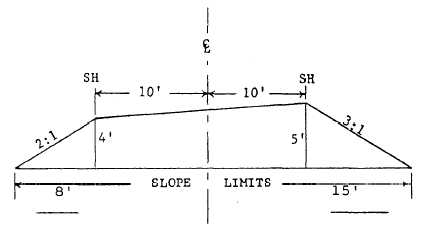Figure 4-7.—Cross section.
Road Nomenclature
Part of the planning and estimating process is
making sure your crew has the understanding of road
terminology (fig. 4-5). Before any construction is
performed on a project site, the elevation is known as
existing grade. The driving surface of an existing road
that is to be replaced is also known as the existing grade.
The subgrade of a road is a prepared base for the
placement of base course materials. The base course is
a select layer of well-compacted soil that is placed in
compacted lifts on top of the subgrade. This compaction
can be accomplished by mechanical stabilization or
chemical stabilization. The sufrace course and the
shoulders complete the road. The surface course is
usually concrete or asphalt and is part of the road that
vehicles travel on. The shoulder of the road performs as
a retainer on each side of the surface course and allows
for an emergency parking area.
The crown of the road is an established slope from
the center line of a roadbed to the outside of the
shoulders and allows for excess water to drain from the
surface into either a V-type or flat bottom ditch. The area
that covers the entire width of the road project including
the ditches is known as the roadway. The roadbed is the
section that includes the surface course and both
shoulders, and the travelway is the surface course that
the vehicle travels on.
Slope Ratio
The two most common slopes used in road
construction are the backslope and foreslope. The
backslope extends from the top of the cut at the existing
grade to the bottom of the ditch. The foreslope extends
from the outside of the shoulder to the bottom of the
ditch. The amount of slope in a backslope or foreslope
is the ratio of horizontal distance to vertical distance (fig.
4-6). This means that for every 1 foot of vertical (up or
down) distance, the horizontal distance changes
proportionally. The following are equations used to
compute slope ratio:
1.
2.
3.
If the base and the height are known
factors, but not the slope, use:
Base ÷ Height = Slope
(B ÷ H = S)
If the slope ratio and height are known factors,
but not the base, use:
Slope x Height = Base
(S x H = B)
If the base and the slope ratio are known
factors, but not the height, use:
Base ÷ Slope = Height
(B ÷ S = H)
Cross Sections
A cross-sectional view (fig. 4-7) that is given for a
road project is a cutaway end view of a proposed station
between the left slope and the right slope. Typical cross
sections are plotted at any intermediate place where
there is a distance change in slope along the center line
where the natural ground profile and grade line
correspond. The cross section displays the slope limits,
slope ratio, horizontal distance between centerline
stakes and shoulder stakes. It also shows the vertical
distance of the proposed cut or fill at the shoulder and
centerline stakes.
4-7

